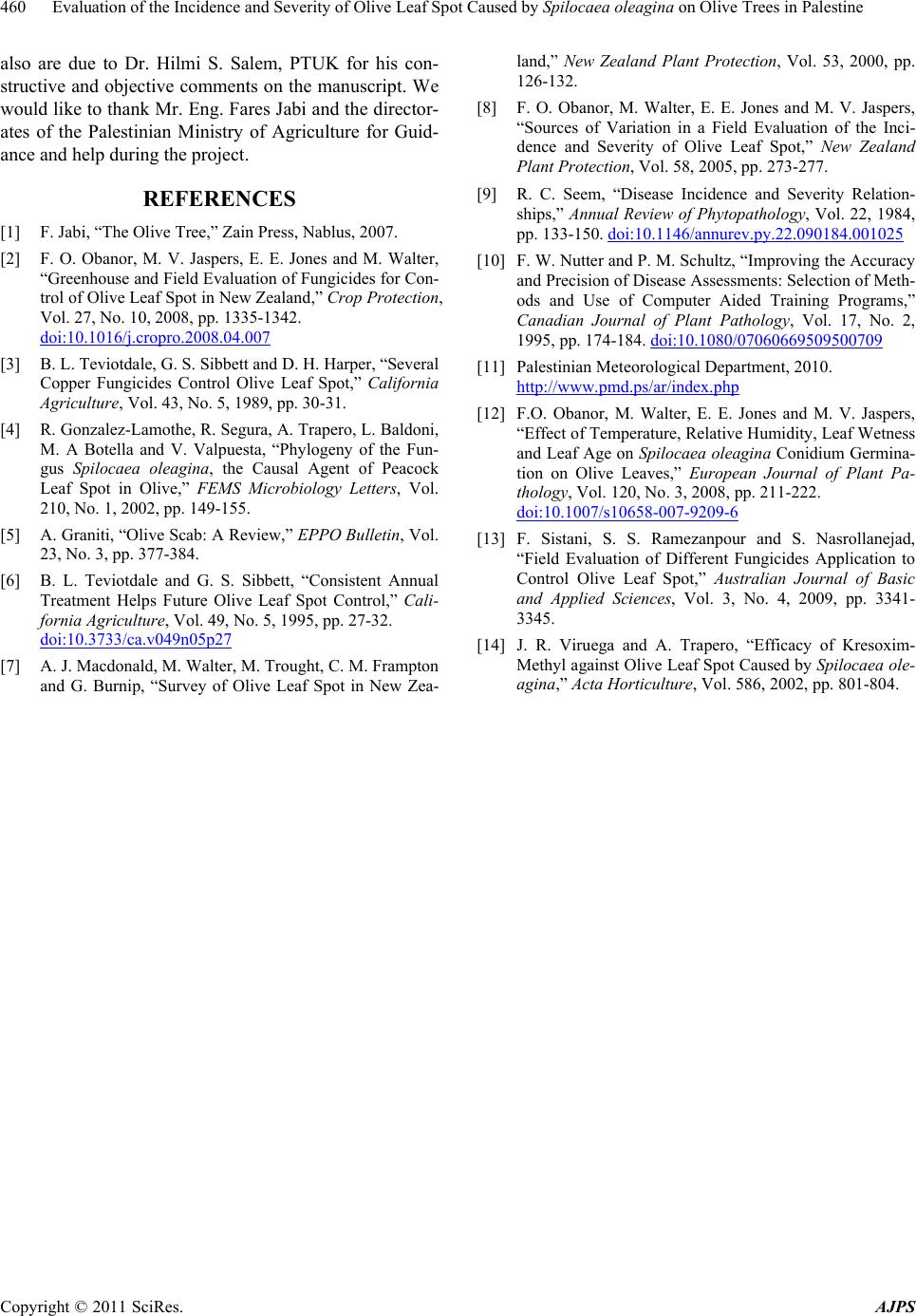
Evaluation of the Incidence and Severity of Olive Leaf Spot Caused by Spilocaea oleagina on Olive Trees in Palestine
Copyright © 2011 SciRes. AJPS
460
also are due to Dr. Hilmi S. Salem, PTUK for his con-
structive and objective comments on the manuscript. We
would like to thank Mr. Eng. Fares Jabi and the director-
ates of the Palestinian Ministry of Agriculture for Guid-
ance and help during the project.
REFERENCES
[1] F. Jabi, “The Olive Tree,” Zain Press, Nablus, 2007.
[2] F. O. Obanor, M. V. Jaspers, E. E. Jones and M. Walter,
“Greenhouse and Field Evaluation of Fungicides for Con-
trol of Olive Leaf Spot in New Zealand,” Crop Protection,
Vol. 27, No. 10, 2008, pp. 1335-1342.
doi:10.1016/j.cropro.2008.04.007
[3] B. L. Teviotdale, G. S. Sibbett and D. H. Harper, “Several
Copper Fungicides Control Olive Leaf Spot,” California
Agriculture, Vol. 43, No. 5, 1989, pp. 30-31.
[4] R. Gonzalez-Lamothe, R. Segura, A. Trapero, L. Baldoni,
M. A Botella and V. Valpuesta, “Phylogeny of the Fun-
gus Spilocaea oleagina, the Causal Agent of Peacock
Leaf Spot in Olive,” FEMS Microbiology Letters, Vol.
210, No. 1, 2002, pp. 149-155.
[5] A. Graniti, “Olive Scab: A Review,” EPPO Bulletin, Vol.
23, No. 3, pp. 377-384.
[6] B. L. Teviotdale and G. S. Sibbett, “Consistent Annual
Treatment Helps Future Olive Leaf Spot Control,” Cali-
fornia Agriculture, Vol. 49, No. 5, 1995, pp. 27-32.
doi:10.3733/ca.v049n05p27
[7] A. J. Macdonald, M. Walter, M. Trought, C. M. Frampton
and G. Burnip, “Survey of Olive Leaf Spot in New Zea-
land,” New Zealand Plant Protection, Vol. 53, 2000, pp.
126-132.
[8] F. O. Obanor, M. Walter, E. E. Jones and M. V. Jaspers,
“Sources of Variation in a Field Evaluation of the Inci-
dence and Severity of Olive Leaf Spot,” New Zealand
Plant Protection, Vol. 58, 2005, pp. 273-277.
[9] R. C. Seem, “Disease Incidence and Severity Relation-
ships,” Annual Review of Phytopathology, Vol. 22, 1984,
pp. 133-150. doi:10.1146/annurev.py.22.090184.001025
[10] F. W. Nutter and P. M. Schultz, “Improving the Accuracy
and Precision of Disease Assessments: Selection of Meth-
ods and Use of Computer Aided Training Programs,”
Canadian Journal of Plant Pathology, Vol. 17, No. 2,
1995, pp. 174-184. doi:10.1080/07060669509500709
[11] Palestinian Meteorological Department, 2010.
http://www.pmd.ps/ar/index.php
[12] F.O. Obanor, M. Walter, E. E. Jones and M. V. Jaspers,
“Effect of Temperature, Relative Humidity, Leaf Wetness
and Leaf Age on Spilocaea oleagina Conidium Germina-
tion on Olive Leaves,” European Journal of Plant Pa-
thology, Vol. 120, No. 3, 2008, pp. 211-222.
doi:10.1007/s10658-007-9209-6
[13] F. Sistani, S. S. Ramezanpour and S. Nasrollanejad,
“Field Evaluation of Different Fungicides Application to
Control Olive Leaf Spot,” Australian Journal of Basic
and Applied Sciences, Vol. 3, No. 4, 2009, pp. 3341-
3345.
[14] J. R. Viruega and A. Trapero, “Efficacy of Kresoxim-
Methyl against Olive Leaf Spot Caused by Spilocaea ole-
agina,” Acta Horticulture, Vol. 586, 2002, pp. 801-804.